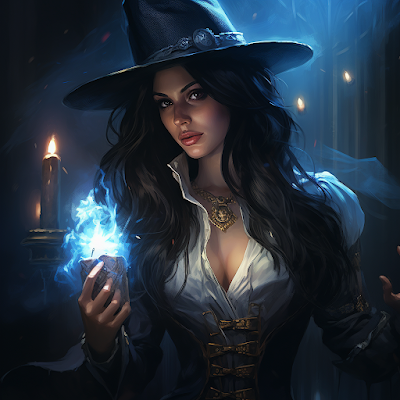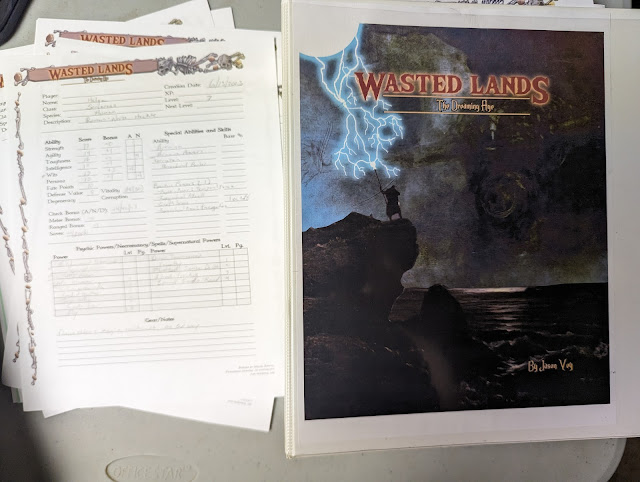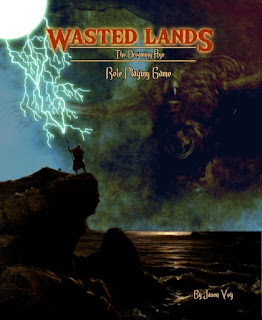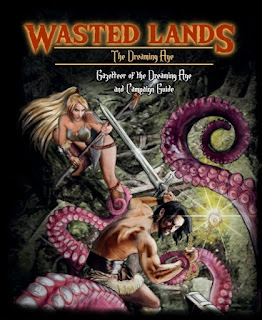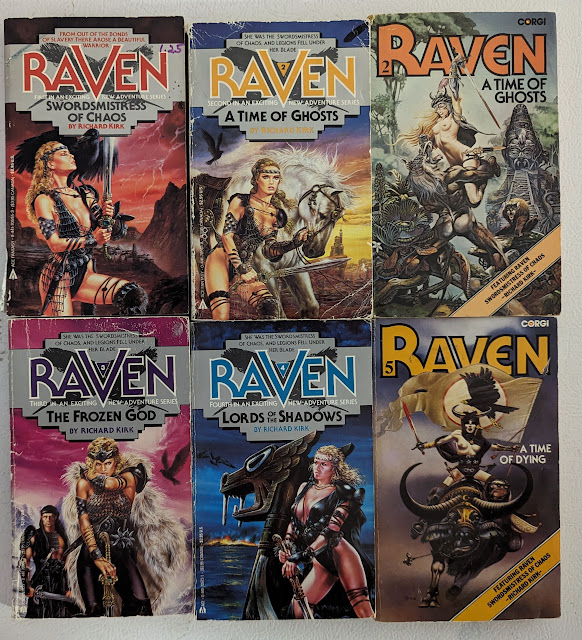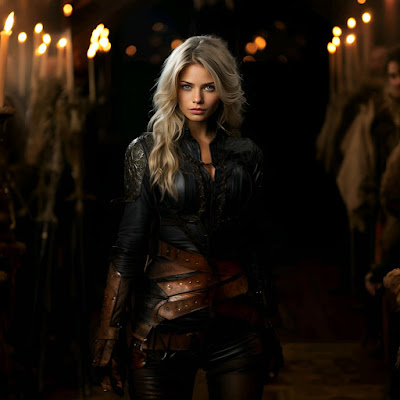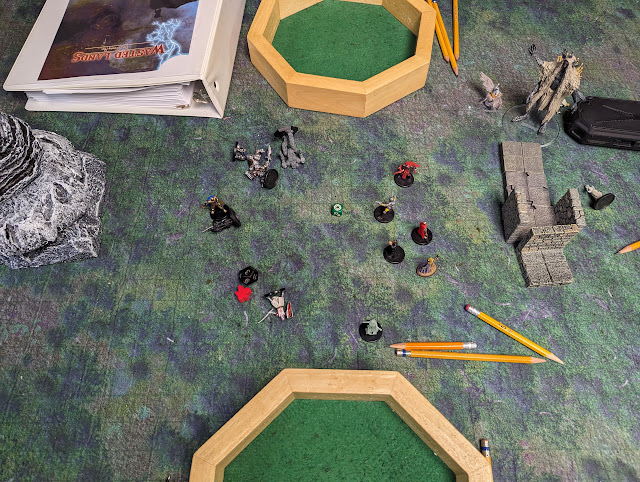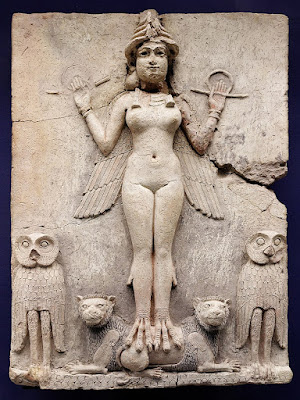One of the things that bugged me the most about playing FRPGs of the 70s and 80s was that wizards, supposedly after having all this training in magic and magical philosophy and thought could only do one spell. Per day. While I understand
why it was set up like that, it never really made much sense that they wouldn't know more. After all, look at the Harry Potter kids in the first book/movie, they knew all sorts of spells at age 11. We can hand wave it and say it takes years just to master the basics, but it still seems a bit light to me.
So following in the footsteps of the game's
Advanced cousin and introduce the idea of cantrips, or 0-level spells.
These spells by their nature need to be simple things, plus they should also be useful to the magic-user in question. Little spells they learn to see the effects of spells in a teaching environment and something they can safely use while practicing. So given that cantrips must satisfy these requirements for me.
- They need to be simple effects.
- They should not cause damage.
- All the cantrips a magic-user knows will be learned in school before 1st level.
The effects should never be anything near the effects of a 1
st level spell. They would be "utility" type spells that would work just like all other spells. They would have to be memorized, though the time to do so is minimal and once cast they are forgotten for that day's use. Note: Some Game Masters may allow wizards to use cantrips at will.
Also, given their nature, cantrips cannot be reversed. Unless otherwise stated a cantrip has no effect on a living creature. So a wizard cannot place an Arcane Mark on a person or animal nor can Warm be used to warm up a person. It can be used on a bed or blanket and then the person can use the now warmed bed or blanket.
Magic users know three (3) cantrips before 1
st level + a bonus number equal to their Intelligence modifier. So a magic-user with Intelligence of 18 knows 3 + 3 cantrips, 6. This gives this 1
st level magic use a total of 7 spells (6 cantrips and 1
st level), a magically potent number.
Alarm Ward
Level: 0
Range: 50' radius
Duration: 1 hour
Effect: sets up an area of warning
With this spell the magic-user can set up a area of alarm 50' around his/her person. Any creature larger than a cat entering the radius will set off a mental alarm within the caster. They will not know what sort of creature had entered their area but they will know one has and the general direction.
Arcane Mark
Level: 0
Range: 1 object touched
Duration: Permanent
Effect: Leaves a permanent mark on an object
By means of this spell the magic-user can place a personal mark on any non-living item. This mark is usually a personal glyph or sigil that is recognizable to all other magic users. They may not know who the owner is, but they will know it is owned by another wizard. The mark itself is not magical.
Black Flame
Level: 0
Range: 1 normal fire
Duration: Instant
Effect: Colors one normal flame
This spell changes a normal fire into one with dark flames so it casts no light, but still provides heat. The fire loses some of it's heat. While the flames do provide heat they do not burn, though they are uncomfortable to the touch.
Chill
Level: 0
Range: 1 object touched
Duration: 1 hour
Effect: Lowers the temperature of one object to a few degrees
The magic-user can use this spell to lower the temperature of any non-living material up to 1 cubic foot. Typical uses are to cool food or drinks or even to cool the air in a room that is too warm. The temperature cannot be lowered to a degree where it would cause anything damage. The temperature can lowered to just above freezing.
Clean
Level: 0
Range: 1 object touched
Duration: 1 hour
Effect: cleans one object
This spell can be used to clean a single object. The object can be anything, clothing, armor, weapons or even a area of a home. Unlike other cantrips this one can be cast on a willing living participant. A magic-user casting
clean on themselves will appear as they would if they had recently bathed and donned fresh clothing. This spell can clean 1 cubic foot of space or an area 10' x 10'.
Close
Level: 0
Range: Within 10' of caster
Duration: Instant
Effect: Closes an open, un-barred door or window.
This spell creates allows the caster to close one door or window that is not locked or otherwise barred. This cantrip will not lock the door or window unless by the action of closing it naturally becomes locked.
False Glamour
Level: 0
Range: One item
Duration: Instant
Effect: Makes one object appear to be an illusion
This simple illusion will cause a solid object or creature to flicker and blur faintly, as if it were a flawed image. Failed attempts to disbelieve the illusion will appear to succeed, giving the object or creature the false appearance of a translucent outline.
Flavor
Level: 0
Range: One item
Duration: Instant
Effect: Flavors one serving
This minor spell flavors one serving of food. The flavor can be changed but it does not change the nature of the food item nor does make poisoned food or spoiled food edible, similar to
Freshen. The flavor can be chosen by the magic-user.
Freshen
Level: 0
Range: One Item
Duration: Instant
Effect: Removes wrinkles, flavors or brightens one object
This minor spell allows the magic user to "freshen" one object up to 1 cubic foot. Typical uses are to remove the wrinkles in a garment, brighten the color or some non-living object, or even make bland food more favorable, or polishing metal or glass. All these effects are considered to be a minor illusion. This spell cannot make poisoned or spoiled food edible.
Lift
Level: 0
Range:
Duration: 1 hour
Effect: Slowly lifts 1 pound or less of non-living material
The magic user may use this spell to lift an object via magic alone. The object needs to be non-living and weigh less than 1 pound. The object will remain floating in mid-air for up to one-hour as long as the magic-user is paying at least some attention to it. If the magic-user is distracted at all, say in combat or casting another spell (including a cantrip) then the object drops.
Mend
Level: 0
Range: 1 object touched
Duration: Instant
Effect: Fixes minor wear and tear in non-living and non-metal apparel
By means of this spell the magic-user can mend or repair non-living and non-metal material. Typically this spell is used on clothing to reattach a button, fix a tear or rip or other minor repairs. The amount of material mended cannot exceed 1 cubic foot. This spell can also be used on minor household wear and tear as well. It cannot fix a dented piece of armor or sharpen a sword, but it can reattach a leather strap to armor or fix a pane of glass if all the pieces are present.
Message
Level: 0
Range: 1 known person
Duration: Instant
Effect: Sends a quick message to a single person
By means of this spell the magic-user can end a brief message, no more than a dozen words, to a person they know. This person can be any distance away and be able to understand the magic-users language or at least the language of the message.
Mote of Light
Level: 0
Range: Within 10' of caster
Duration: 1 hour
Effect: Creates a small mote of light equal to candle light
This spell creates a small mote of light roughly equal to candle light that hovers near the magic-user's head. The spell is typically used for reading or lighting a small area (1 cubic foot). It is not a replacement for the Light or Continual Light spells. This spell cannot be cast into someone's eyes. The spell is not useful for lighting dark passages unless that passage is very well known (such as the magic-users' own home).
Open
Level: 0
Range: Within 10' of caster
Duration: Instant
Effect: Opens an unlocked, un-barred door or window.
This spell creates allows the caster to open one door, window, chest or other item that is not locked or otherwise barred.
Palm
Level: 0
Range: 1 small object
Duration: Instant / 1 hour
Effect: the caster can hide one small object
This spell allows the caster to take an object that would normally fit into a closed fist and make it disappear. The item is not invisible, it is simply gone. The item can be recalled up to one hour later. After one hour the item returns to the caster's hand.
Puff of Air
Level: 0
Range: Within 10' of caster
Duration: Instant
Effect: Creates a small puff of air. Enough to remove dust or put out one candle
This spell creates a small puff of air; enough to blow away dust from objects or to put out a candle, but not enough to put out a torch or lantern. The puff can move very light items as would a puff of air blown from natural means. This spell can be used to blow dirt from an item or area 10' by 10'.
Quick Sleeping
Level: 0
Range: 1 willing subject
Duration: 8 hours till woken up
Effect: Puts a willing target falls asleep
This spell allows the caster to make a willing creature fall asleep. The spell will not work if used against an unwilling subject. The caster can cast this spell on herself, but obviously, this will be the last spell that she casts in that day.
Sound
Level: 0
Range: Within 100' of caster
Duration: One Sound
Effect: Creates a ghostly moan 100' from the caster
By means of this spell the magic-user can create a ghostly moaning sound that appears to come from 100' from the caster. The moan is not loud nor can it quite cause fear, but any that hear it will know of it's "unnatural" nature.
Spark
Level: 0
Range: Within 100' of caster
Duration: Instant
Effect: Creates a small spark, enough to light a candle
The caster can light a single candle up to 100' feet away. This spell is not enough to start a torch, ignite oil or start a campfire unless there is something that burns very easy used; such as paper or old leaves. The effect is the same of a spark from a set of flint and steel. Some magic-users will use this spell to light a pipe.
Warm
Level: 0
Range: 1 object touched
Duration: 1 hour
Effect: Raises the temperature of an object a few degrees.
This spell will warm 1 cubic feet of material a few degrees. Typical uses are to warm food or drinks or even to warm the air in a room that is too cool. The temperature cannot be raised to a degree where it would cause anything damage.
Section 15 Copyright Notice
Open Game License v 1.0a Copyright 2000, Wizards of the Coast, Inc.
System Reference Document Copyright 2003, Wizards of the Coast, Inc.; Authors Jonathan Tweet, Monte Cook, Skip Williams, Bruce R. Cordell, based on original material by E. Gary Gygax and Dave Arneson.
Liber Mysterium: The Netbook of Witches and Warlocks is Copyright© 2003, Timothy S. Brannan and the Netbook of Witches Team.
Basic Fantasy Role-Playing Game Copyright © 2006-2008. Chris Gonnerman.
Labyrinth LordTM. Copyright © 2007, Daniel Proctor. Author Daniel Proctor.
"Cantrips for Original and Basic era FRPGs" Copyright ©2010, Timothy S. Brannan


